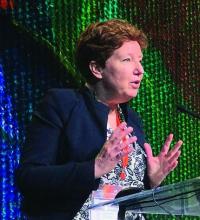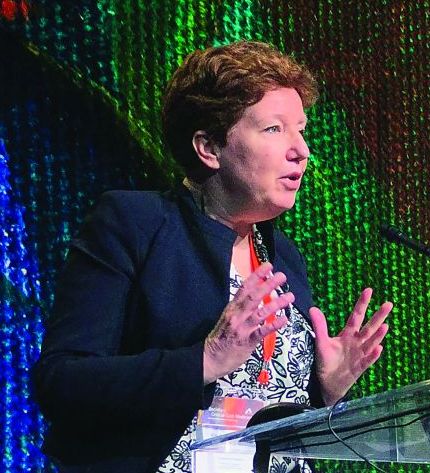User login
SAN ANTONIO – with both medications, according to the results of a randomized clinical trial presented by Frederique Paulus, RN, PhD.
In this study, adverse events such as tachyarrhythmia and agitation were less frequent with the on-demand approach, in which patients receive nebulization based on strict clinical indications, Dr. Paulus reported at the Critical Care Congress sponsored by the Society for Critical Care Medicine. The study was published simultaneously in JAMA.
The on-demand approach may also be cost saving, she noted, citing an economic analysis underway that is not yet ready for publication.
“In our ICU, it will save us 350,000 Euros a year,” she said. “In the Netherlands, 40,000 patients will be mechanically ventilated in a year, so it will save us millions in the Netherlands alone.”
The study included adult ICU patients who were expected not to be extubated for at least 24 hours. Dr. Paulus presented the primary analysis of the study, which included data for 922 patients who were randomized either to the on-demand group (n = 455) or the routine nebulization group (n = 467) and completed follow-up.
Patients assigned to the on-demand group received acetylcysteine-containing solutions if they had thick or tenacious secretions, or salbutamol-containing solutions if wheezing was observed or suspected or when findings were suggestive of lower-airway obstruction, according to the paper, published in JAMA.
The primary outcome, number of ventilator-free days at day 28 of the study, was noninferior in the on-demand group versus the routine group, Dr. Paulus said.
The median number of ventilator-free days was 21 for the on-demand group and 20 for the routine group, said the paper.
The length of stay, mortality, and proportion of patients developing pulmonary complications did not differ between the two study arms, the investigators also reported in JAMA.
However, adverse events occurred in just 13.8% of the on-demand group, compared with 29.3% of the routine group (P less than .001), with the difference in adverse events mainly attributable to less tachyarrhythmia and agitation in the experimental group, according to the researchers.
Dr. Paulus and coauthors reported no conflicts of interest related to the study.
SOURCE: Paulus F et al. (van Meenen DMP et al.) JAMA. 2018 Feb. doi: 10.1001/jama.2018.0949.
I would suspect local practice patterns with nebulized acytylcysteine to vary even more widely than bronchodilator administration strategies.
I would suspect local practice patterns with nebulized acytylcysteine to vary even more widely than bronchodilator administration strategies.
I would suspect local practice patterns with nebulized acytylcysteine to vary even more widely than bronchodilator administration strategies.
SAN ANTONIO – with both medications, according to the results of a randomized clinical trial presented by Frederique Paulus, RN, PhD.
In this study, adverse events such as tachyarrhythmia and agitation were less frequent with the on-demand approach, in which patients receive nebulization based on strict clinical indications, Dr. Paulus reported at the Critical Care Congress sponsored by the Society for Critical Care Medicine. The study was published simultaneously in JAMA.
The on-demand approach may also be cost saving, she noted, citing an economic analysis underway that is not yet ready for publication.
“In our ICU, it will save us 350,000 Euros a year,” she said. “In the Netherlands, 40,000 patients will be mechanically ventilated in a year, so it will save us millions in the Netherlands alone.”
The study included adult ICU patients who were expected not to be extubated for at least 24 hours. Dr. Paulus presented the primary analysis of the study, which included data for 922 patients who were randomized either to the on-demand group (n = 455) or the routine nebulization group (n = 467) and completed follow-up.
Patients assigned to the on-demand group received acetylcysteine-containing solutions if they had thick or tenacious secretions, or salbutamol-containing solutions if wheezing was observed or suspected or when findings were suggestive of lower-airway obstruction, according to the paper, published in JAMA.
The primary outcome, number of ventilator-free days at day 28 of the study, was noninferior in the on-demand group versus the routine group, Dr. Paulus said.
The median number of ventilator-free days was 21 for the on-demand group and 20 for the routine group, said the paper.
The length of stay, mortality, and proportion of patients developing pulmonary complications did not differ between the two study arms, the investigators also reported in JAMA.
However, adverse events occurred in just 13.8% of the on-demand group, compared with 29.3% of the routine group (P less than .001), with the difference in adverse events mainly attributable to less tachyarrhythmia and agitation in the experimental group, according to the researchers.
Dr. Paulus and coauthors reported no conflicts of interest related to the study.
SOURCE: Paulus F et al. (van Meenen DMP et al.) JAMA. 2018 Feb. doi: 10.1001/jama.2018.0949.
SAN ANTONIO – with both medications, according to the results of a randomized clinical trial presented by Frederique Paulus, RN, PhD.
In this study, adverse events such as tachyarrhythmia and agitation were less frequent with the on-demand approach, in which patients receive nebulization based on strict clinical indications, Dr. Paulus reported at the Critical Care Congress sponsored by the Society for Critical Care Medicine. The study was published simultaneously in JAMA.
The on-demand approach may also be cost saving, she noted, citing an economic analysis underway that is not yet ready for publication.
“In our ICU, it will save us 350,000 Euros a year,” she said. “In the Netherlands, 40,000 patients will be mechanically ventilated in a year, so it will save us millions in the Netherlands alone.”
The study included adult ICU patients who were expected not to be extubated for at least 24 hours. Dr. Paulus presented the primary analysis of the study, which included data for 922 patients who were randomized either to the on-demand group (n = 455) or the routine nebulization group (n = 467) and completed follow-up.
Patients assigned to the on-demand group received acetylcysteine-containing solutions if they had thick or tenacious secretions, or salbutamol-containing solutions if wheezing was observed or suspected or when findings were suggestive of lower-airway obstruction, according to the paper, published in JAMA.
The primary outcome, number of ventilator-free days at day 28 of the study, was noninferior in the on-demand group versus the routine group, Dr. Paulus said.
The median number of ventilator-free days was 21 for the on-demand group and 20 for the routine group, said the paper.
The length of stay, mortality, and proportion of patients developing pulmonary complications did not differ between the two study arms, the investigators also reported in JAMA.
However, adverse events occurred in just 13.8% of the on-demand group, compared with 29.3% of the routine group (P less than .001), with the difference in adverse events mainly attributable to less tachyarrhythmia and agitation in the experimental group, according to the researchers.
Dr. Paulus and coauthors reported no conflicts of interest related to the study.
SOURCE: Paulus F et al. (van Meenen DMP et al.) JAMA. 2018 Feb. doi: 10.1001/jama.2018.0949.
REPORTING FROM CCC47
Key clinical point: Compared with routine nebulization with acetylcysteine or salbutamol, on-demand nebulization with acetylcysteine or salbutamol was noninferior among patients receiving invasive ventilation in the ICU.
Major finding: At day 28, the median number of ventilator-free days was 21 in the on-demand group and 20 in the routine care group.
Data source: Primary analysis of a randomized clinical trial including 922 adult patients who were expected to need at least 24 hours of invasive ventilation at one of seven ICUs in the Netherlands.
Disclosures: Authors reported no conflicts of interest related to the study.
Source: Paulus F et al. (van Meenen DMP et al.) JAMA. 2018 Feb. doi: 10.1001/jama.2018.0949.


